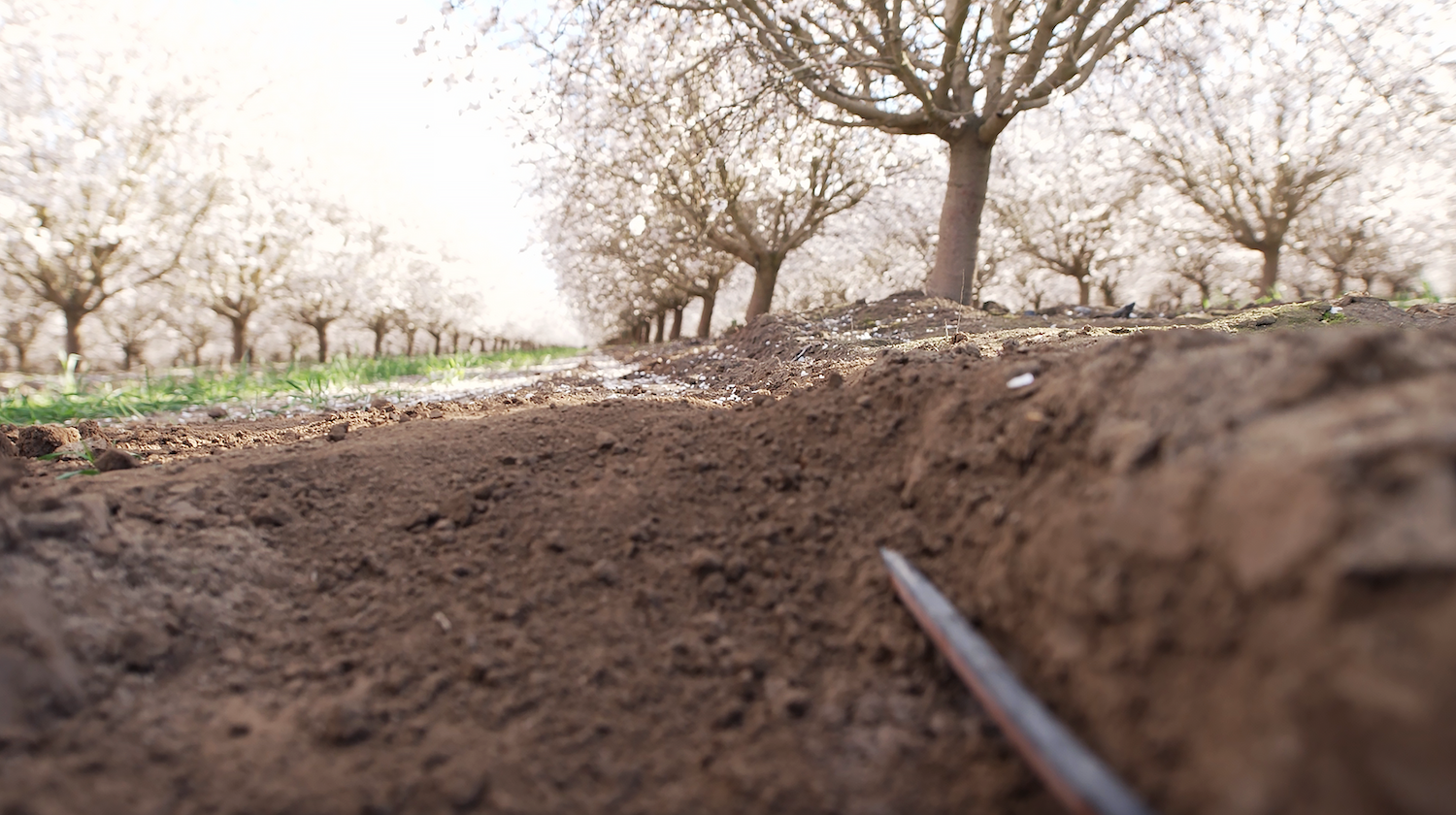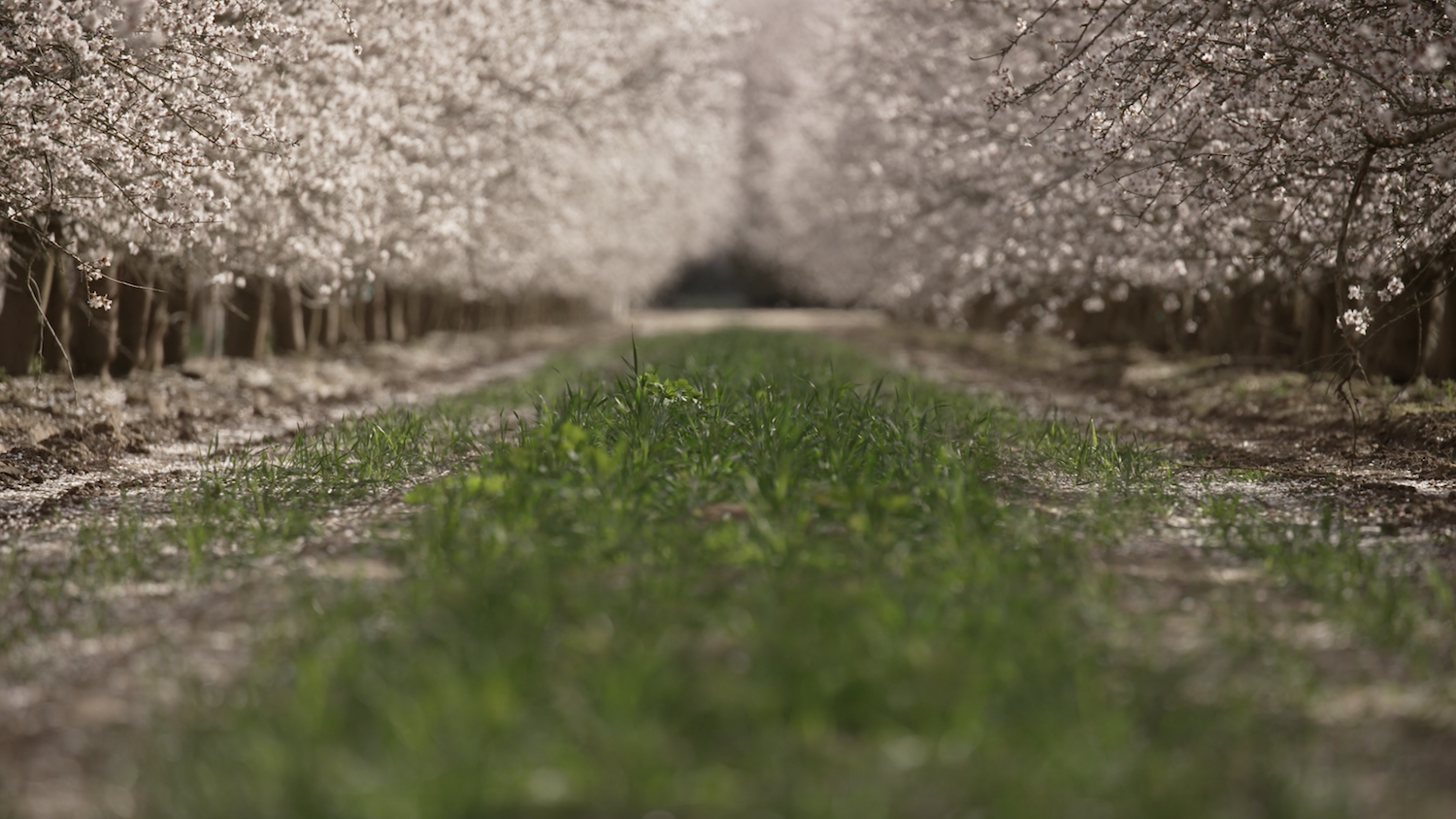
(Image courtesy of Kind Snacks.)
Orchards blanketing California’s Central Valley produce 80 percent of the world’s supply of almonds, and all of ours in the United States. Touted as a superfood, they’ve soared in popularity since the 1980s — with Californian production increasing seven times since then. Filled with nutrients and antioxidants, almonds help lower cholesterol and blood pressure, strengthen bones, and improve blood sugar control and gut health.
But almonds are a thirsty crop, which can be problematic under water shortages in California. So Kind Snacks, a producer of snack bars and cereal, is delving into the nuts and bolts of almond farming. Last year, it launched a three-year pilot program, the Almond Acres Initiative, to test regenerative agriculture and new technologies in partnership with one of its top suppliers, Ofi.
With a year of promising progress under their belt, the organizations are expanding the Central Valley project to include a second, drier site. Undaunted by dust and dehydration, they’re hoping to make our favorite nut a little better for everyone.
The bitter side of almond orchards
Almonds give us marzipan, Amaretto, amaretti cookies and so much more. But there’s a downside to this delicious nut.
It’s no secret almonds need a lot of water. With 3.2 gallons required per nut, that’s a higher water footprint than other major California crops. However, this elevated water use is in line with other fruit and nut trees.
Further, that water doesn’t just go toward nuts — other parts of the almond tree can be put to use too. The protective layer around the almond shell, the hull, can be used as livestock feed, while the shells can be used as mulch or bedding.
Besides water, pesticides are also applied in abundance on almonds. In 2022, nearly 31 million pounds were used in California, making almonds one of the state’s dirtiest crops. These chemicals can damage biodiversity, harm workers and people living nearby, and pollute water, soil and air.
But it’s not all bad news in almond orchards. Almonds have a relatively small carbon footprint, 20 times lower than that of beef. And almond milk production requires less land and water than dairy milk and causes less pollution.
Kind’s approach in a nutshell
Despite these challenges, Kind launched an ambitious project to improve almond production.
“When we launched Kind’s Almond Acres Initiative in 2023 last year, we started with the commitment that 100 percent of our almonds would be sourced from farms leveraging regenerative agriculture by 2030,” said Lindsay Philpott, sustainability communications manager at Kind.
Regenerative agriculture focuses on soil health while also improving yields, lowering water use and reducing carbon emissions. To reach that goal, Kind and Ofi are testing five agricultural approaches and a new set of tech tools.
“We're starting to test there with the hopes that the test will give us the information we need to scale across our supply chain to meet that 2030 commitment,” Philpott said. “So getting as much information out of this pilot as possible, so we can go to other growers and say, ‘Here, we've tested this over the course of three years. Here's what we're finding. Here are the practices we think would be most beneficial. And here's how we can support you in scaling those practices.’”
While the pilot project started with an initial 500 acres in Madera County, California, that acreage is doubling. The new test site, located in Bakersfield, California, was chosen due to its drier climate.
Kind is not alone in its endeavors. It’s working in collaboration with a whole cadre of partners including the California Water Action Institute, the Pollinator Partnership, the University of California, Davis, and the University of California, Merced.
From pollination to high-tech tools
The Almond Acres Initiative starts at the very beginning: pollination. Similar to many crops, bees are critical for almond farming. Yet honeybees are in trouble. In 2023, nearly half the colonies in the U.S. died from pests and disease, extreme weather, lack of food, pesticides and climate change.
Kind is testing a new approach to addressing the issue with the beekeeping tech company Beewise. It’s using a solar-powered beehive combined with robotics and artificial intelligence to combat bee decline. By detecting problems early on, it reduced colony losses by 70 percent. And closing the hive can reduce bees’ exposure to pesticides.
Once the bees have done their part and the almonds start growing, Kind is testing a number of other regenerative agriculture techniques.
For example, burying irrigation lines underneath the soil saves water. Known as subsurface drip irrigation, this technology has used 30 percent less water in the pilot so far, said Zac Ellis, senior director of agronomy at Ofi. It also reduced the amount of weeds, translating into fewer herbicide applications, and decreased humidity, reducing disease risk. But this type of irrigation system is more expensive to install than a traditional one, and pocket gophers can pose a problem.

Another technique in the testing mix is cover crops. Planted between the trees, they improve soil health, prevent erosion, suppress weeds and encourage water infiltration. These plants also provide forage for pollinators and uptake carbon.
Kind also applies compost and biochar, or a charcoal-like substance made from burning almond shells, to the soil. These materials improve soil quality, retain water and sequester carbon. But since biochar is expensive, they’re also examining if applying almond shells alone can do the job. If that weren’t enough, a fertilizer with a significantly lower manufacturing carbon footprint is also part of the test.
A set of high-tech tools from Landscan helps optimize these last techniques. The company produces high-resolution spatial mapping of soils four feet in depth. This detailed information on soil quality and nutrients helps target applications of fertilizer and biochar, potentially reducing their use.
Harvesting to an almond tree’s end
Once those delicious almonds are ready for harvesting, Kind has another suite of approaches up its sleeve. At harvest time, almonds are normally shaken off the trees and then swept into rows. For this project, an off-ground harvester catches almonds directly from the trees and then lays them in rows to dry. Bypassing the sweeping step reduces soil disturbance, dust and equipment use. While the current adoption of this technology is low, Kind hopes its pilot can demonstrate the benefits to farmers.
In the final phase — when almond trees are nearing the end of their productive lifespan — they’re recycled. Traditionally trees are burned, but areas of California are phasing out the practice. In contrast to this fiery end, whole-orchard recycling involves grinding old almond trees into chips. This biomass is applied to the orchard floor where it improves soil health, nutrient levels and water retention, and eventually boosts almond yields. This method can be costly, but some financial incentives are available for farmers.

Almond farming for the future
Overall, these practices improve sustainability while also fighting climate change. For example, practices like whole tree recycling and low-carbon fertilizer reduce an orchard’s carbon footprint, Philpott said. And soil health practices help sequester carbon while bolstering orchards against weather extremes like flooding or drought.
“The reality is we're working in California, which is on the front lines of the changing climate,” Philpott said. “So it's not something that's far off in the future that we're trying to do now. We're actively working to adapt.”
Since the pilot is ongoing, it’s too early to share concrete results. But Kind is excited by some of the progress it’s seeing in soil health so far, Philpott said.
The path forward
As the state’s top-valued agricultural export, the almond industry was worth $4.65 billion in 2022. The global almond market is predicted to grow by 5.5 percent until 2029.
Kind’s pilot project could help soften the industry’s impact while providing a variety of benefits for the environment and farmers alike.
“If we know that one of our larger impact ingredients is almonds, and we buy a lot of them, how can we move the needle in a way that's impactful not only for Kind and our goals but for the broader industry?” Philpott said. “That's our hope.”
Editor's Note: Travel and accommodations to California’s Central Valley were provided by Kind Snacks. Neither the author nor TriplePundit were required to write about the experience.

Ruscena Wiederholt is a science writer based in South Florida with a background in biology and ecology. She regularly writes pieces on climate change, sustainability and the environment. When not glued to her laptop, she likes traveling, dancing and doing anything outdoors.














